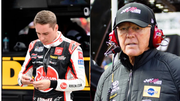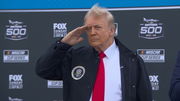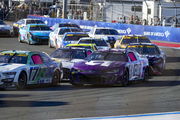
via Imago
Rusty Wallace USA, Miller Lite Dodge, starts his final season. NASCAR, Motorsport, USA Nextel Cup, Rd1, Daytona 500, Daytona International Speedway, Daytona, Florida, USA. 14 February 2005. DIGITAL IMAGE PUBLICATIONxINxGERxSUIxAUTxHUNxONLY dne0515fe30

via Imago
Rusty Wallace USA, Miller Lite Dodge, starts his final season. NASCAR, Motorsport, USA Nextel Cup, Rd1, Daytona 500, Daytona International Speedway, Daytona, Florida, USA. 14 February 2005. DIGITAL IMAGE PUBLICATIONxINxGERxSUIxAUTxHUNxONLY dne0515fe30
NASCAR fans believe Rusty Wallace to be one of the greatest racing legends of the early 2000s. As speed is one of the ultimate thrills of the sport, Wallace recently shared a story that includes an unforgettable moment based on a Nextel-sponsored test session at Talladega Superspeedway. That tale from 2004 holds a special place in the hearts of many NASCAR enthusiasts.
Rusty Wallace described driving without a restrictor plate in a sponsored test session
The story of Rusty Wallace breaking the 200 mph barrier in a test session is quite fascinating as he had to ignore the standard practice of installing restrictor plates because of his sponsor’s call. Though the task was risky, he managed to exceed 200 mph without the plate on his automobile.
ADVERTISEMENT
Article continues below this ad
While describing how Nextel managed to convince him for that high-speed test session at Talladega, the Hall of Famer said to his brother, “So I get a phone call about six months into the new contract, that we’re racing about six months into the year now with the Nextel Cup series. Ok. And they[Nextel] say we want to start broadcasting the driver’s communications to a tower and from the tower down to the, the, all the fans of the grandstands.”
While stating how much speed he had to touch, Rusty noted that Nextel asked him to try to drive above 200 mph to test the transmission of the signals sent back and forth. He continued, “And I said, ok, and back then you remember the cars were running like 100 and 92 miles an hour, that’s all they were running with the restrictor plate. Ok. So they said, ok, well, they asked me if I would do it and I said, yeah, we’ll do it. So ask team Penske if they would.”
Wallace easily achieved an unbridled 220+ mph speed during the test session, with no other racers in attendance. After the trial, Rusty Wallace was very confident about generating more speed, noting, “I’ll bet we could be running speeds up to 235 without the plates if we spent time doing some tweaking.”
When word spread out that Rusty Wallace hit such a speed at Talladega Superspeedway, Tony Stewart joined the chorus of critics. He spoke out against the prevailing style of restrictor plate racing, echoing a sentiment that more speed equated to more excitement.
Trending
Tony Stewart performed as a main critic against restrictor plate
Speaking out against NASCAR’s restrictor-plate racing, Tony Stewart made news in 2004 when he joked that fans weren’t seeing enough crashes on the track. He may not be a fan of pack racing, but his bold racing style didn’t work well with the limits that restrictor plates put in play.
ADVERTISEMENT
Article continues below this ad
That year, Stewart pushed for a ban on restrictor plates in NASCAR, arguing that it would provide drivers and teams more freedom. He pointed to Rusty Wallace’s near-228 mph lap at Talladega without restrictor plates as evidence. Without restrictor plates, Stewart said, racing would be more exciting because drivers would have to think more strategically and compete with greater intensity.
He stated, “If you had cars running in the 215 to 220 mph bracket, you wouldn’t be able to run that close to each other because you’d have to move around on the race track to find clean air…I think it would make for exciting racing to be able to do that again.”
ADVERTISEMENT
Article continues below this ad
The use of the safety plates became necessary after a dangerous incident involving Bobby Allison in 1987 at Talladega, prompting NASCAR to implement them for safety reasons. Though the joy of racing comes from driving as fast as possible, being safe is more important than anything else.
ADVERTISEMENT
ADVERTISEMENT
ADVERTISEMENT
ADVERTISEMENT






